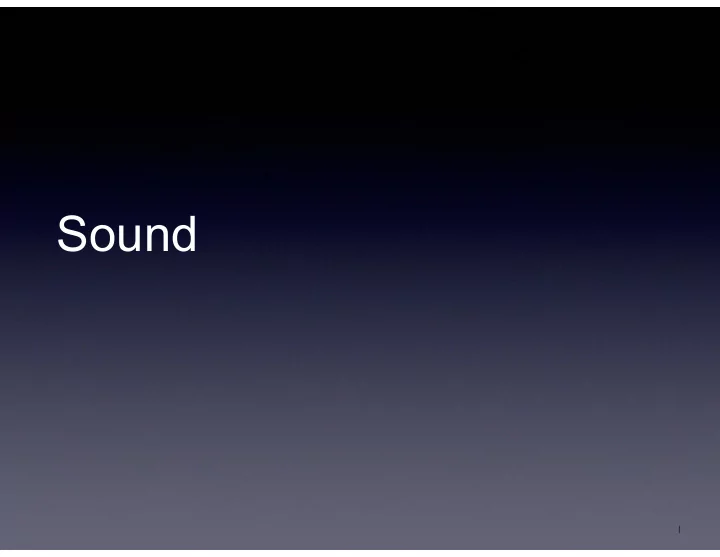

Sound 1
Sound "50% of the movie experience is sound” - George Lucas • Sound is used to create: – Mood – Ambience – Drama – Environmental clues – Continuity – Feedback
Practical Issues • Real-time requirement – Must keep the hardware fed at all times – Drop-outs are much more noticeable • Easy to annoy with bad sound • Hard to impress with good sound • Resource intensive – Memory for uncompressed audio, in particular • Final quality entirely dependent on hardware – Lousy speakers sound lousy • Wide variation of hardware – May or may not support surround, hardware reverb, occlusion, etc.
Sound Effects • When something happens in the game that would make a sound, make it. • Some level of this is almost required to make the game feel right • Can use a very simple API – playSound(“explosion”) • Main concern is when / what to play
Music Playback • Playback of sampled music – Samples retrieved from disc for longer clips – Very few restrictions on instrumentation • MIDI (sequenced) – Score itself is very compact – Instrument bank might be huge though – Composers don't like the restrictions – Information available about tempo, can be used for stitching • Music from the users audio library – May not have full control over playback / mixing
Music in Games • Often we have to provide over 10 hours of musical score for a game – Contrast this with a movie score • Two systems employed – Big long audio tracks – Compose the music out of smaller, stitchable clips, and play them back with randomization and overlays • Interactive Music – Score changes to suit situation – Very effective when done properly – Chunks of music re-ordered and overlaid to create different moods
Ambience • Can add an incredible amount of depth and realism to a scene – Augments scene complexity beyond what graphics alone can achieve • Examples: – weather (wind, rain) – cityscape (footsteps, engine hum) – nature (bird chirps, insect buzz, flowing water) • Implementation: – A looped track to define the general soundscape – Periodic randomized event sounds (dog barks, police sirens, etc.) • Generally an area effect – Initiated with trigger volumes – Cross fade between ambient zones
Environmental Effects • Echoes • Doppler shifts • Sound occlusion • Pitch bend • Positional sound processing
Compression • Due to the size of audio data, it is always compressed on disc, and uncompressed before use. – Could be very late, particularly if hardware can read compressed format directly • There is usually hardware to do this for you. • Lossless, and lossy schemes are employed. – Lossless (MLP, FLAC): 2:1 – Lossy non-perceptual (ADPCM): 2-4:1 – Lossy perceptual (MP3, AC3): 6-12:1
Sound Hardware • Often have build in in capabilities – Hardware decompression – Hardware voices / mixing – Surround sound decode – Hardware effects • Can often emulate well in software if you don’t have them – Amenable to SIMD & Multi core optimization – Need to be sure you can run the operation fast enough
Sound Software Architecture • At least two layers – Hardware abstraction • Platform abstraction, manages hardware resources, buffer management, I/O, mixing, positional, effects • Often runs in its own thread – Game layer • Event processing, entity management • Needs – Listener position (often the camera position) – World representation – Event passing mechanism – Resource management (streaming) system • Game sends high-level events to sound system – Sound engine interprets events and takes appropriate action
Synchronisation • Matching visuals to acoustics – Audio time and game time tend to drift apart – Need accurate clock to avoid drift – Start animation and sound simultaneously – Drive animation from sound events • E.g. end of phoneme triggers next animation in speech – HAL often provides sample notification events • or use timers or polling – Drive long cinematic sequences with “sound sample clock” • I.e. measure time by how much sound has actually left the system – Beware of external equipment latencies • Bluetooth headphones, etc • Although there is little you can do about them
Clipping • Occurs when mixed dynamic range exceeds hardware capabilities • Hardware either: – wraps (argh!) – clamps (still sounds awful) • Bad, very bad, nasty, awful when it happens • Avoid by not running full volume voices • Counteract with DSP – Dynamics compressor/limiter
Streaming • Needed when: – Sample too big to fit into memory – Hardware has limits on sample size – Decompression is required • Use double or ring buffer – Ring is more space-efficient – Need 1-2 seconds in buffer • More if disk access is shared – Use sample notifier or timer to start next fetch • Don’t use when latency is a concern • Remember: drop-outs are bad
Building the Audio Environment • Create sound layers, then mix together – Background ambience effects • Wind, crowd murmur, machinery hum, water – Specific ambience effects • Car horns in the distance, construction, aircraft flying overhead – Foreground effects (foley) • Engine, UI elements, collisions, tire screeching, dialogue – Music • All layers are mixed against each other to form a cohesive presentation – Some hardware will mix (“hardware voices”) • Need to carefully consider how sounds interact (ducking, etc)
Authoring Sound • Offline mix – Clean up pop, crackle, hiss – Initial levels – Loops – Stereo effects – Sequence points • Real time processing – Directional pan, attenuate – Reverb – Doppler shift – Occlusion – Sequencing
Conclusion • Important aspect of the feel of your game – But less easy to notice than graphics • Give it due time in your schedule • Be aware of hardware capabilities
Recommend
More recommend